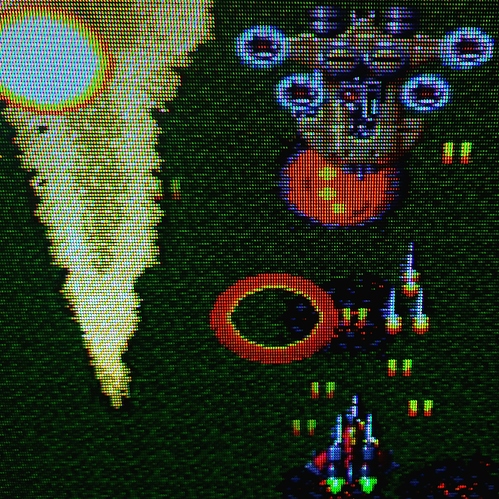@ Cyber
I just made some screenshots with my smartphone off the LG GX OLED TV. All shots from the Retroarch Megatron shader.
This is with the Megatron Default Preset, Aperture Grille, Mask accurate, RGB subpixel layout and 300 TVL:
This is with the Megatron Default Preset, Slot Mask, Mask accurate, RGB subpixel layout and 300 TVL:
This is with the Virtua Fighter Preset, Slot Mask, Mask accurate, RGB subpixel layout and 300 TVL:
As you can see, there are no issues with the Aperture Grille and RGB subpixel layout. To my surprise, I discovered, that the Virtua Fighter preset has a very nice slot mask, which I was not getting with the Megatron Default Preset.
Despite the blue subpixels slightly overlapping the green subpixels, resulting in a very fine cyan colored line, this looks great to me! I thought I could only use Aperture Grille with the Megatron shader due to the weird looking Slot Mask in the Default Preset, but this changed my mind. You just have to compare all presets and see what works best here. I read before, that other users had also issues with the weirld looking Slot Mask, so I would suggest to try a different Preset such as the Virtua Fighter one.
Also the maximum luminance and paperwhite values are very different in the Virtua Fighter preset when compared to the Megatron Default preset.
In the VF preset I can’t go over 300 nits paperwhite, as this results in overblown highlights and clipping, as with the MT default preset I can go all the way up to 800 nits paperwhite, while still looking good.
Bottom line is, that the Megatron shader is very versatile and all presets work very differently. Also while reshade has a Megatron setting called “Neutral” which has the saturation slider at a value of 0, the Retroarch Megatron shader has no Neutral preset and only the Preset called Megatron Default, which I thought would be the same. But when I go into the settings here, the saturation value is set @ 0.45 which oversaturates colors.
So the reshade Neutral preset and the Retroarch Default preset are not the same and these are some of the differences between the reshade and Retroarch ports and I think I would discover even more, if I dig deeper.




 ) will also have a look why the whitepoint and green primary are off the targets.
) will also have a look why the whitepoint and green primary are off the targets.




